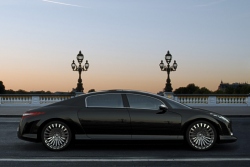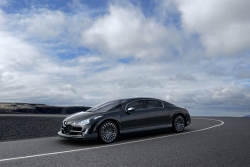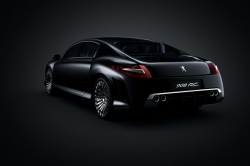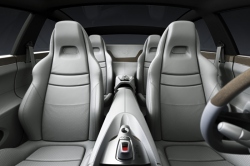
.
. .
..
. . .
© 1998 -
2006 Copyright & |
The 908 RC The ultimate by Peugeot The raison d’être of a concept car is to explore new ideas and to test the ideas in an attempt to create the ultimate solution. Know-how and passion, combined with imagination, then become the motive force that turns the dream into reality.
Two particulate filters are located at the end of each exhaust system ensuring the car’s environmentally-friendly credentials. Exterior style The design of the 908 RC creates a particularly low-lying exterior body with a stylish tapered design at the front of the vehicle. Its proportions create an elegant and dynamic statement. Sitting on large diameter 20 spoke alloy wheels (20’’ at the front, 21’’ at the rear); the overall effect is that of a big cat, from the nose at the front, to the tip of the rear lights. More than ever, the Marque’s emblem has played a part in fashioning the power of expression of the 908 RC. Inside the 908 RC The ambience inside the 908 RC is the result of meticulous attention to detail on the part of the car’s designers. Thanks to a forward-positioned passenger compartment made possible by the car’s architecture, and a large glazed surface area of 3 m2, occupants are truly at one with the road and the passing landscape. The special shape of the huge front windscreen allows a completely unimpeded fi eld of vision (as on the RC concept cars). The front windscreen stretches back behind the driver’s head, as far as the B/C post where the glazed roof begins. This gives both front and rear passengers a sense of being at one with the outside environment. Unequalled brightness and visibility combine with a generous interior space, complete with four independent seats, helping to create a truly exceptional ambience. Structure and Suspension In the great tradition of Peugeot concept cars, the 908 RC is a unique model conceived in the inner sanctum of the Peugeot Design Centre. The vehicle is built around a pre-impregnated carbon composite and vacuum-polymerised aluminium honeycomb structure. The rear section is a self-supporting shell incorporating a sub-frame consisting of a tubular structure on which the engine and suspension are assembled. Both at the front and the rear, the car features a drop link, double wishbone type suspension, derived from the 407. Braking is by means of four monobloc ceramic carbon composite discs which reduce weight and improved thermal effi ciency. The wheels are fi tted with Michelin Pilot Sport PS2 255/35 R20 tyres at the front and 285/30 R21 at the rear.
|
.
|









